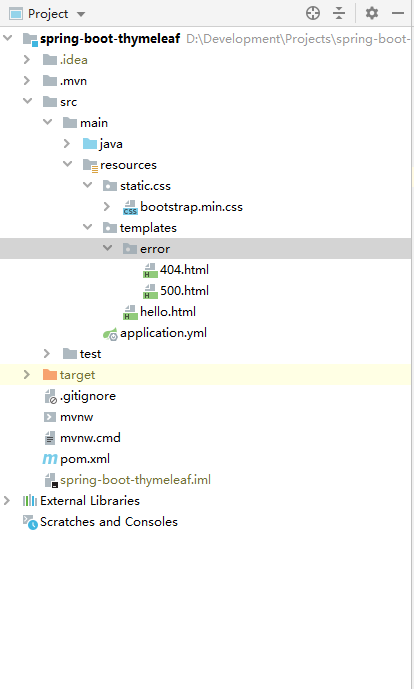Spring Boot (二):模版引擎 Thymeleaf 渲染 Web 頁面
Spring Boot (二):模版引擎 Thymeleaf 渲染 Web 頁面

在《Spring Boot(一):快速開始》中介紹瞭如何使用 Spring Boot 構建一個工程,並且提供 RESTful API ,本節我們繼續介紹如何使用 Spring Boot 渲染 Web 頁面。
1. 什麼是 Thymeleaf ?
雖然我們目前擁有許多十分優秀的前端框架,例如: Vue 、 React 等,非常適用於前後端分離的場景,前端可以獨立部署成為服務,前後端從物理上完全進行隔離,降低程式耦合度。但是 Spring Boot 官方依然為我們提供了模版引擎用於一些無需前後端分離的場景。 Thymeleaf 是新一代的模板引擎,在 Spring Boot 中,官方推薦使用 Thymeleaf 來做前端模版引擎。開啟 https://start.spring.io/ 可以看到,在當前Spring Boot 的版本中( 2.1.8.RELEASE ), 官方提供的模版引擎有以下幾種:
- Thymeleaf
- FreeMarker
- Mustache
- Groovy
Spring Boot 建議使用這些模版引擎,而並不推薦我們繼續使用 JSP 。
Thymeleaf 具體特性如下:
- Thymeleaf 在有網路和無網路的環境下皆可執行,即它可以讓美工在瀏覽器檢視頁面的靜態效果,也可以讓程式設計師在伺服器檢視帶資料的動態頁面效果。這是由於它支援 html 原型,然後在 html 標籤裡增加額外的屬性來達到模板+資料的展示方式。瀏覽器解釋 html 時會忽略未定義的標籤屬性,所以 Thymeleaf 的模板可以靜態地執行;當有資料返回到頁面時,Thymeleaf 標籤會動態地替換掉靜態內容,使頁面動態顯示。
- Thymeleaf 開箱即用的特性。它提供標準和 Spring 標準兩種方言,可以直接套用模板實現 JSTL、 OGNL表示式效果,避免每天套模板、改 Jstl、改標籤的困擾。同時開發人員也可以擴充套件和建立自定義的方言。
- Thymeleaf 提供 Spring 標準方言和一個與 SpringMVC 完美整合的可選模組,可以快速的實現表單繫結、屬性編輯器、國際化等功能。
2. 快速入門
這裡我們先正常構建一個 Spring Boot 工程: spring-boot-thymeleaf ,在 pom.xml 檔案中引入 Thymeleaf 的相關依賴,如下:
<dependency> <groupId>org.springframework.boot</groupId> <artifactId>spring-boot-starter-thymeleaf</artifactId> </dependency>
工程的配置檔案 application.yml 如下:
server:
port: 8080
spring:
application:
name: spring-boot-thymleaf
thymeleaf:
# 關閉thymeleaf快取 開發時使用 否則沒有實時畫面
cache: false
# 檢查模板是否存在,然後再呈現
check-template-location: true
# Content-Type value.
servlet:
content-type: text/html
# 啟用MVC Thymeleaf檢視解析度
enabled: true
# Template encoding.
encoding: UTF-8
# 關閉嚴格模式
mode: LEGACYHTML5
# Prefix that gets prepended to view names when building a URL.
prefix: classpath:/templates/
# Suffix that gets appended to view names when building a URL.
suffix: .html
mvc:
# 指定靜態資源處理路徑
static-path-pattern: /static/**
view:
suffix: .html有關 thymeleaf 都寫明瞭註釋,這裡需要注意的有以下幾點:
- spring.thymeleaf.mode :這裡是配置當前模版的解析模式的,預設值為 HTML ,這時會開啟嚴格模式,所有的 HTML 必須有頭有尾,很多地方並不符合我們平時的書寫習慣,這裡最好關閉嚴格模式。
- spring.thymeleaf.cache :這裡是 thymeleaf 的快取,在平時的練習中最好關閉,否則頁面修改後重新整理瀏覽器將會無效,而在生產環境中,視具體的業務場景而定。
- spring.mvc.static-path-pattern :這裡是配置我們靜態資源的路徑,一般預設是配置
/static/**路徑,這裡用於存放我們的 js 、 css 、圖片等靜態資源。
配置通用 404 和 500 頁面,直接在 templates\error 建立對應頁面即可,這裡可以看一下 Spring Boot 錯誤頁面轉發的原始碼 org.springframework.boot.autoconfigure.web.servlet.error.DefaultErrorViewResolver,如下:
@Override
public ModelAndView resolveErrorView(HttpServletRequest request, HttpStatus status, Map<String, Object> model) {
ModelAndView modelAndView = resolve(String.valueOf(status.value()), model);
if (modelAndView == null && SERIES_VIEWS.containsKey(status.series())) {
modelAndView = resolve(SERIES_VIEWS.get(status.series()), model);
}
return modelAndView;
}
private ModelAndView resolve(String viewName, Map<String, Object> model) {
String errorViewName = "error/" + viewName;
TemplateAvailabilityProvider provider = this.templateAvailabilityProviders.getProvider(errorViewName,
this.applicationContext);
if (provider != null) {
return new ModelAndView(errorViewName, model);
}
return resolveResource(errorViewName, model);
}可以看到這裡會根據當前的狀態響應碼轉發到對應的頁面,路由為 error/** 。筆者這裡簡單建立兩個錯誤頁面,如圖:

建立測試 Controller ,如下:
@Controller
public class HelloController {
@GetMapping("/hello")
public String hello(HttpServletRequest request) {
// 構建測試資料
Map<String, Object> map = new HashMap<>();
UserModel userModel = new UserModel();
userModel.setId(1L);
userModel.setName("Spring Boot");
userModel.setAge(18);
map.put("user", userModel);
List<CourseModel> list = new ArrayList<>();
for (int i = 0; i < 2; i++) {
CourseModel courseMode = new CourseModel();
courseMode.setId((long) i);
courseMode.setName("Spring Boot:" + i);
courseMode.setAddress("課程地點:" + i);
list.add(courseMode);
}
map.put("list", list);
map.put("flag", true);
request.setAttribute("data", map);
return "hello";
}
}在此註冊測試類中,進行資料初始化並輸出至頁面。
- Thymeleaf 預設的模板路徑
src/main/resources/templates,只需要在這個這個路徑下編寫模版檔案即可。
Thymeleaf 模版檔案如下:
<!DOCTYPE html>
<html xmlns="http://www.w3.org/1999/xhtml"
xmlns:th="http://www.thymeleaf.org">
<head>
<meta charset="UTF-8">
<meta name="viewport" content="width=device-width, initial-scale=1, shrink-to-fit=no">
<title>Hello Spring Boot</title>
<link rel="stylesheet" th:href="@{/static/css/bootstrap.min.css}">
</head>
<body>
<div class="container">
<div>使用者資訊:</div>
<table class="table table-dark">
<thead>
<tr>
<th scope="col">#</th>
<th scope="col">姓名</th>
<th scope="col">年齡</th>
</tr>
</thead>
<tbody>
<tr>
<th scope="row" th:text="${data.user.id}"></th>
<td th:text="${data.user.name}"></td>
<td th:text="${data.user.age}"></td>
</tr>
</tbody>
</table>
<div>課程資訊:</div>
<table class="table table-dark">
<thead>
<tr>
<th scope="col">#</th>
<th scope="col">課程名稱</th>
<th scope="col">課程地點</th>
</tr>
</thead>
<tbody>
<tr th:each="course, iterStat : ${data.list}">
<th scope="row" th:text="${course.id}"></th>
<td th:text="${course.name}"></td>
<td th:text="${course.address}"></td>
</tr>
</tbody>
</table>
<div th:if="${data.flag == true}">如果 flag 為 true 你將可以看到這行字:)</div>
</div>
</body>
</html>Thymeleaf 部分常用 th 標籤如下:
| 關鍵字 | 功能介紹 | 案例 |
|---|---|---|
| th:id | 替換id | <input th:id="'xxx' + ${collect.id}"/> |
| th:text | 文字替換 | <p th:text="${collect.description}">description</p> |
| th:utext | 支援html的文字替換 | <p th:utext="${htmlcontent}">conten</p> |
| th:object | 替換物件 | <div th:object="${session.user}"> |
| th:value | 屬性賦值 | <input th:value="${user.name}" /> |
| th:with | 變數賦值運算 | <div th:with="isEven=${prodStat.count}%2==0"></div> |
| th:style | 設定樣式 | th:style="'display:' + @{(${sitrue} ? 'none' : 'inline-block')} + ''" |
| th:onclick | 點選事件 | th:onclick="'getCollect()'" |
| th:each | 屬性賦值 | tr th:each="user,userStat:${users}"> |
| th:if | 判斷條件 | <a th:if="${userId == collect.userId}" > |
| th:unless | 和th:if判斷相反 | <a th:href="@{/login}" th:unless=${session.user != null}>Login</a> |
| th:href | 連結地址 | <a th:href="@{/login}" th:unless=${session.user != null}>Login</a> /> |
| th:switch | 多路選擇 配合th:case 使用 | <div th:switch="${user.role}"> |
| th:case | th:switch的一個分支 | <p th:case="'admin'">User is an administrator</p> |
| th:fragment | 佈局標籤,定義一個程式碼片段,方便其它地方引用 | <div th:fragment="alert"> |
| th:include | 佈局標籤,替換內容到引入的檔案 | <head th:include="layout :: htmlhead" th:with="title='xx'"></head> /> |
| th:replace | 佈局標籤,替換整個標籤到引入的檔案 | <div th:replace="fragments/header :: title"></div> |
| th:selected | selected選擇框 選中 | th:selected="(${xxx.id} == ${configObj.dd})" |
| th:src | 圖片類地址引入 | <img class="img-responsive" alt="App Logo" th:src="@{/img/logo.png}" /> |
| th:inline | 定義js指令碼可以使用變數 | <script type="text/javascript" th:inline="javascript"> |
| th:action | 表單提交的地址 | <form action="subscribe.html" th:action="@{/subscribe}"> |
| th:remove | 刪除某個屬性 | <tr th:remove="all"> 1.all:刪除包含標籤和所有的孩子。2.body:不包含標記刪除,但刪除其所有的孩子。3.tag:包含標記的刪除,但不刪除它的孩子。4.all-but-first:刪除所有包含標籤的孩子,除了第一個。5.none:什麼也不做。這個值是有用的動態評估。 |
| th:attr | 設定標籤屬性,多個屬性可以用逗號分隔 | 比如 th:attr="src=@{/image/aa.jpg},title=#{logo}" ,此標籤不太優雅,一般用的比較少。 |
3. 測試
啟動當前工程,開啟瀏覽器訪問路徑: http://localhost:8080/hello ,結果如圖:

5. 程式碼示例
示例程式碼-Github
示例程式碼-Gitee
6. 參考
《Thymeleaf 使用詳解
